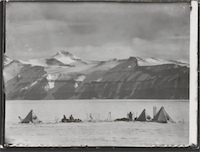Famed explorer Ranulph Fiennes teams up with Cambridge to save Antarctic photos
posted Monday, March 10, 2014 at 1:43 PM EDT

Sir Ranulph Fiennes, in addition to being a baronet and OBE, has one of the most amazing titles you'll ever hear: "world's greatest living explorer". Now, this famed traverser of wilderness has teamed up with the The Polar Museum at Cambridge University in an attempt to raise the funds to stop a priceless historical artifact from being sold at auction. The negatives from Captain Robert Falcon Scott’s ill-fated attempt on the South Pole are set to go under the auctioneer's hammer in just one month, unless £275,000 can be raised.
Scott's travels in Antarctica, and his eventual death attempting to reach the South Pole, were the stuff of legends for years. While more recent analyses point out the myriad of flaws in his attempt, his time in Antarctica was still immensely important. And, while there, he took a series of negatives that are some of the first photographs of Antarctica. While prints of many of these images are widely available, the negatives themselves (which include some never before seen photos), are coming up for auction. However, if the The Scott Polar Research Institute can raise sufficient funds, the sellers have agreed to sell them directly to the institute.
Fiennes has stepped in to spearhead the fundraising initiative, saying:
“The negatives of Scott’s lost photographs are of major significance to the national heritage. Scott’s attainment of the South Pole and his subsequent death captured the public imagination on its discovery in 1913 and continues to exercise an extraordinary fascination. The negatives are a key component of the expedition’s material legacy as an object and as a collection in themselves. Although the Scott Polar Research Institute holds prints of a number of these photographs, acquiring the negatives is very important. They take us right back to the point of origin, a fact made all the more exciting given that the Institute also holds the camera on which they were taken. Unlike a print, of which any number can be made, the negatives are unique and would be a huge asset to the Institute.”
If you're interested in supporting this fundraising endeavor, you can donate here.
Early images such as these provide a fascinating look at the history of what's still one of the most barren and astonishing places on the planet. Much like the negatives recently rediscovered and saved from the ice, they give us insight into some of the first attempts to survive the one of the most inhospitable places in the world.
(via ePhotoZine)